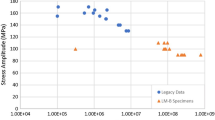Abstract
Fatigue crack propagation ratesda/dN in binary Al alloys with 3.6 wt pct Cu and 6.3 wt pct Cu and commercial 2024 aged at 21°C were compared with 99.95+ wt pct aluminum. Omitting an anomalous region at lowΔK, the extrapolated rates for “pure” aluminum are more than 100 times greater than those in the three alloys at the same ΔK. The data for the alloys fit into a single scatter band of a factor of three. It was suggested thatda/dN varies inversely with the square of the strength of the alloy but that another parameter related to the fatigue crack propagation energy per unit area is also important. Theda/dN vs ΔK curves were determined for 3.6 wt pct Cu single crystals aged seven days at 21°C which containGP zones and two and seven days at 160°C which contain mixtures ofθ′ andθ′’. No systematic variation of (da/dN Δ with crystallographic orientation was discerned, but the naturally aged specimen had a strong orientation dependence on crack initiation. At low ΔK 21°C aged specimens gave the lowestda/dN while at high ΔK the warm aged specimens gave the lower values ofda/dN. Measurement ofda/dN vs ΔK curves were conducted on specimens of 3.6 wt pct Cu with 1 mm equiaxed grains aged for various times at 130°C, 160°C, and 190°C. All warm aged specimens experienced brittle intergranular fracture at sufficiently high ΔK. The transition ΔK where intergranular fracture first appears is inversely proportional to the aging temperature. The change of fracture mode from intra to intergranular occurs gradually over a broad range of ΔK which shifts to lower ΔK with increase in aging temperature.
Similar content being viewed by others
References
S. Pearson:Nature, 1966, vol. 211, p. 1077.
M. O. Speidel:Technica, 1974, vol. 3, p. 162.
A. J. McEvily: inThe Microstructure and Design of Alloys, vol. 2, Proc. 3rd Intl. Conf. on the Strength of Metals and Alloys, Cambridge, England, August 20 to 25, 1973.
J. T. Staley:Fracture Toughness and Microstructure of High Strength Aluminum Alloys, presented at Spring Meeting of The Metallurgical Society of AIME, Pittsburgh, Pa., May 23,1974.
H. L. Marcus, W. L. Morris, O. Buck, and J. D. Frandsen: inProspectives of Fracture Mechanics, G. C. Sih, H. C. Van Elst, and B. Brook, eds., p. 179, Nordhoff Intl., Leiden, Holland, 1974.
F. A. McClintock: inFatigue Crack Propagation, p. 140, ASTM STP no. 415, 1967, (discussion to paper by C. Laird).
P. N. Thielen and M. E. Fine:Met. Trans. A, 1975, vol. 6A, p. 2133.
L. P. Pook: inStress Analysis and Growth of Cracks, p. 106, Proc. 1971 Natl. Sym. on Fracture Mechanics, part I, ASTM STP 513, ASTM 1972.
P. C. Paris, R. J. Bucci, E. T. Wessel, W. E. Clark, and T. R. Mager: inStress Analysis and Growth of Cracks, pp. 141–76, Proc. 1971 Natl. Sym. on Fracture Mechanics, part I, ASTM STP 513, ASTM 1972.
J. Weertman:Int. J. Fract. Mech., 1966, vol. 2, p. 460.
J. Weertman:Int. J. Fract. Mech., 1973, vol. 9, p. 125.
J. Weertman:Int. J. Fract. Mech., 1969, vol. 5, p. 13.
L. H. Burck: Ph.D. Thesis,The Effect of Mechanical Properties on Fatigue Crack Growth Rates in Fe-Ni and Fe-Mo Alloys, Northwestern University, Evanston, Illinois, 1975.
T. Mura and C. T. Lin:Int. J. Fract. Mech., 1974, vol. 10, p. 284.
T. Mura and C. T. Lin:Theoretical Prediction of Fatigue Crack Propagation Rates in Notched Specimens, unpublished research.
S. Majumdar and J. Morrow: University of Illinois, T. & A.M. Rept. No. 364, 1973.
J. M. Silcock, T. J. Heal, H. K. Hardy:J. Inst. Metals, 1953–1954, vol. 82, p. 239.
J. G. Byrne, M. E. Fine, and A. Kelly:Phil. Mag., 1961, vol. 6, p. 1119.
D. Dew-Hughes and W. D. Robertson:Acta Met, 1960, vol. 8, p. 147.
R. J. Price and A. Kelly:Acta Met., 1964,vol. 12, p. 159; R. J. Price and A. Kelly: ibid, 1964, vol. 12, p. 979.
J. S. Santner: Ph.D. Thesis, Northwestern University, Evanston, Illinois, 1975.
G. T. Hahn, R. G. Hoagland, and A. R. Rosenfield:Met. Trans., 1972, vol. 3, p. 1189.
J. R. Rice: ASTM STP 415, p. 247, 1967.
D. T. Raske and J. Morrow: inManual on Low Cycle Fatigue Testing, p. 1, ASTM STP 465, ASTM 1969.
C. Calabrese and C. Laird:Mater. Sci. Eng., 1974, vol. 13, p. 141; ibid, 1974, vol. 13, p. 159; Mer. Trans., 1974, vol. 5, p. 1785.
P. J. Cain, R. Plunkett, and T. E. Hutchinson:J. Eng. Matls. and Tech. Trans. ASME, 1975, vol. 97, p. 179.
J. C. Grosskruetz:J. Appl. Phys., 1962, vol. 33, p. 1787.
A. Hartman, F. A. Jacobs, A. Nederveen, and P. de Rijk: Aerospace Research Laboratories, Netherlands, Tech. Rept. no. M2182, 1966.
E. Roberts and R. W. K. Honeycombe:J. Inst. Metals, 1962–1963, vol. 91, p. 134.
D. W. Hoeppner: inFatigue Crack Propagation, p. 486, ASTM STP 415, ASTM 1967.
A. J. McEvily and R. C. Boettner:Acta Met., 1963, vol. 11, p. 725.
W. Elber: inDamage Tolerance in Aircraft Structures, p. 230, ASTM STP 486, ASTM 1971.
O. Buck, J. D. Frandsen, and H. L. Marcus:Eng. Fract. Mech., 1975, vol. 7, p. 167.
K. P. Byrne: University of Southhampton Institute of Sound and Vibration Research, Tech. Rept. No. 61, August 1973.
Author information
Authors and Affiliations
Additional information
This research was supportd by U.S. Air Force Office of Scientific Research, Office of Aerospace REsearch, Grant No. AF-AFOSR-73-2431.
Rights and permissions
About this article
Cite this article
Santner, J.S., Fine, M.E. Fatigue crack propagation in aluminum-base copper alloys. Metall Trans A 7, 583–593 (1976). https://doi.org/10.1007/BF02643972
Received:
Issue Date:
DOI: https://doi.org/10.1007/BF02643972




